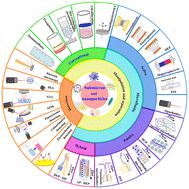Our official English website, www.x-mol.net, welcomes your
feedback! (Note: you will need to create a separate account there.)
Recent microfluidic advances in submicron to nanoparticle manipulation and separation
Lab on a Chip ( IF 6.1 ) Pub Date : 2022-11-01 , DOI: 10.1039/d2lc00793b Samith Hettiarachchi 1 , Haotian Cha 1 , Lingxi Ouyang 1 , Amith Mudugamuwa 2 , Hongjie An 1 , Gregor Kijanka 1 , Navid Kashaninejad 1 , Nam-Trung Nguyen 1 , Jun Zhang 1
Lab on a Chip ( IF 6.1 ) Pub Date : 2022-11-01 , DOI: 10.1039/d2lc00793b Samith Hettiarachchi 1 , Haotian Cha 1 , Lingxi Ouyang 1 , Amith Mudugamuwa 2 , Hongjie An 1 , Gregor Kijanka 1 , Navid Kashaninejad 1 , Nam-Trung Nguyen 1 , Jun Zhang 1
Affiliation

|
Manipulation and separation of submicron and nanoparticles are indispensable in many chemical, biological, medical, and environmental applications. Conventional technologies such as ultracentrifugation, ultrafiltration, size exclusion chromatography, precipitation and immunoaffinity capture are limited by high cost, low resolution, low purity or the risk of damage to biological particles. Microfluidics can accurately control fluid flow in channels with dimensions of tens of micrometres. Rapid microfluidics advancement has enabled precise sorting and isolating of nanoparticles with better resolution and efficiency than conventional technologies. This paper comprehensively studies the latest progress in microfluidic technology for submicron and nanoparticle manipulation. We first summarise the principles of the traditional techniques for manipulating nanoparticles. Following the classification of microfluidic techniques as active, passive, and hybrid approaches, we elaborate on the physics, device design, working mechanism and applications of each technique. We also compare the merits and demerits of different microfluidic techniques and benchmark them with conventional technologies. Concurrently, we summarise seven standard post-separation detection techniques for nanoparticles. Finally, we discuss current challenges and future perspectives on microfluidic technology for nanoparticle manipulation and separation.
中文翻译:

亚微米到纳米粒子操作和分离的最新微流体进展
在许多化学、生物、医学和环境应用中,亚微米和纳米粒子的操作和分离是必不可少的。超速离心、超滤、尺寸排阻层析、沉淀和免疫亲和捕获等传统技术受到成本高、分辨率低、纯度低或对生物颗粒造成损害的风险的限制。微流体可以精确控制数十微米尺寸通道中的流体流动。微流体技术的快速发展使纳米粒子的精确分选和分离成为可能,分辨率和效率均优于传统技术。本文全面研究了微流控技术在亚微米和纳米粒子操纵方面的最新进展。我们首先总结了操纵纳米粒子的传统技术的原理。继微流控技术分为主动、被动和混合方法之后,我们详细阐述了每种技术的物理原理、器件设计、工作机制和应用。我们还比较了不同微流体技术的优缺点,并将它们与传统技术进行了比较。同时,我们总结了七种标准的纳米粒子分离后检测技术。最后,我们讨论了用于纳米粒子操作和分离的微流体技术当前面临的挑战和未来前景。每种技术的工作机制和应用。我们还比较了不同微流体技术的优缺点,并将它们与传统技术进行了比较。同时,我们总结了七种标准的纳米粒子分离后检测技术。最后,我们讨论了用于纳米粒子操作和分离的微流体技术当前面临的挑战和未来前景。每种技术的工作机制和应用。我们还比较了不同微流体技术的优缺点,并将它们与传统技术进行了比较。同时,我们总结了七种标准的纳米粒子分离后检测技术。最后,我们讨论了用于纳米粒子操作和分离的微流体技术当前面临的挑战和未来前景。
更新日期:2022-11-01
中文翻译:

亚微米到纳米粒子操作和分离的最新微流体进展
在许多化学、生物、医学和环境应用中,亚微米和纳米粒子的操作和分离是必不可少的。超速离心、超滤、尺寸排阻层析、沉淀和免疫亲和捕获等传统技术受到成本高、分辨率低、纯度低或对生物颗粒造成损害的风险的限制。微流体可以精确控制数十微米尺寸通道中的流体流动。微流体技术的快速发展使纳米粒子的精确分选和分离成为可能,分辨率和效率均优于传统技术。本文全面研究了微流控技术在亚微米和纳米粒子操纵方面的最新进展。我们首先总结了操纵纳米粒子的传统技术的原理。继微流控技术分为主动、被动和混合方法之后,我们详细阐述了每种技术的物理原理、器件设计、工作机制和应用。我们还比较了不同微流体技术的优缺点,并将它们与传统技术进行了比较。同时,我们总结了七种标准的纳米粒子分离后检测技术。最后,我们讨论了用于纳米粒子操作和分离的微流体技术当前面临的挑战和未来前景。每种技术的工作机制和应用。我们还比较了不同微流体技术的优缺点,并将它们与传统技术进行了比较。同时,我们总结了七种标准的纳米粒子分离后检测技术。最后,我们讨论了用于纳米粒子操作和分离的微流体技术当前面临的挑战和未来前景。每种技术的工作机制和应用。我们还比较了不同微流体技术的优缺点,并将它们与传统技术进行了比较。同时,我们总结了七种标准的纳米粒子分离后检测技术。最后,我们讨论了用于纳米粒子操作和分离的微流体技术当前面临的挑战和未来前景。







































 京公网安备 11010802027423号
京公网安备 11010802027423号